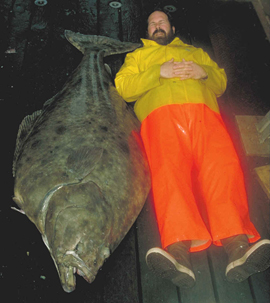Pacific Halibut – Understanding this Vital Member of Alaska’s Fishing Grounds
Oasis Alaska Charters in Ketchikan provide a brief overview of the Pacific halibut’s appearance, range, lifecycle and more
Besides King, Coho and Pink salmon, the Pacific halibut is a vital part of Alaska’s fishery, supporting native villagers, commercial fishing operations and charter guides. On average, over 70 million pounds of halibut are harvested by commercial and recreational anglers annually. Indigenous tribes and villages throughout coastal Alaska have relied on Pacific halibut as a main food source for centuries.

As long-term residents and guides around Ketchikan, Alaska, we understand how important Halibut fishing is to our livelihood. We therefore work tirelessly to help visitors to our little slice of paradise understand how these fish live and how to responsibly harvest them to ensure strong numbers for future generations.
We invite you to continue reading for a few more basic facts about Pacific halibut, including a few ways it’s commonly prepared here in Alaska.
What does the Pacific Halibut look like? What do they eat?
Known in the scientific nomenclature as Hippoglossus stenolepis, the Pacific halibut is a flat fish that spends most of its life along the bottom of the seafloor. Often confused with the Flounder, the Halibut swims sideways and is in fact the largest of all the flat fish.
Halibut are interesting because, unlike salmon, they swim sideways except in the early stages of life. Their top facing side is a grayish brown color coupled with numerous spots that help it blend in with the sea floor, which is where they spend the majority of their time. Halibut are also fascinating because both of their eyes sit on the same side of their body. Most Halibuts’ eyes are on their right side, but approximately 1 in 20,000 will have eyes on their left side.
Their body has the shape of a diamond with the dorsal fin running from right behind their eyes to the base of the tail. Halibuts’ skin has a smooth appearance since its scales are very small and embedded in the body.
For diet, Halibut will feed on plankton when they’re very young, but after their first year, they will start feeding on small fish and crustaceans that closely resemble shrimp. As Halibut mature into adulthood (after age 3), they generally feed on fish like Smelt, Pollock and Cod as well as crabs, clams and even octopus.
The Halibut can be found off Ketchikan and throughout coastal Alaska in waters ranging between 37.4 and 46.4 degrees Fahrenheit. They have been known to go as far south as California on the U.S. coast. Halibut are also found along the Russian and Japanese coasts. They will move closer into shallower waters of the Continental Shelf in the warmer months and move into deeper waters during the winter.
What is the Halibut’s typical lifespan and size? How do they reproduce?
Halibut can live quite a long time – 30 years on average, but over 50 years in some cases. You can tell how old a Halibut is by examining calcified deposits that form growth rings near their ear like you see on trees.
Females grow larger than males since they carry literally millions of eggs for spawning. While most Halibut will weigh between 25 and 30 pounds, some females can weigh as much as 600 pounds! The largest Halibuts, known here in Ketchikan as a “Barn Door,” can grow to be 8 feet long and 5 feet wide. The current state record for Alaska weighed in at 459 pounds.
The Halibut’s spawning season occurs during the winter months, typically between November and March, in anywhere between 300 and 1500 feet of water.
The females will release up to several million eggs depending on their size. The eggs will then be fertilized by the males. Once fertilization occurs, the eggs will hatch in approximately 15 days. The newly born Halibut, or “larvae,” then drift with the deep ocean currents. As they grow, they move higher and higher in the water column until they reach the surface-level currents that carry them to shallower waters and more nutritious fare along the Alaska coast.
By their sixth month, Halibut will stay along the bottom in shallow waters close to shore.
Upon maturity, they will move into much deeper water offshore to spawn.
How do people enjoy Halibut?
Like we explained above, the Halibut is rich in protein and other essential nutrients, and has been a dietary staple for centuries. Its meat is white and has a mild flavor. Indigenous cultures would smoke and dry the meat for winter-time use.
For anglers throughout Alaska, the Halibut is the most popular gamefish just behind the King salmon.
While smoking Halibut is a common preparation method among native Alaskans, the Halibut can be grilled, baked and even pan-fried. Many physicians and nutritionists recommend halibut as a cost-effective way to eat a healthier diet.
If you’re visiting Ketchikan, the Aleutian chain of islands or other parts of coastal Alaska for the first time, you will soon learn why Halibut is an invaluable part of the overall fishery.
We invite you to continue browsing our site to learn more about halibut fishing in Ketchikan and throughout Alaska, and if you have any questions or would like to schedule a charter, please don’t hesitate to contact us today.
